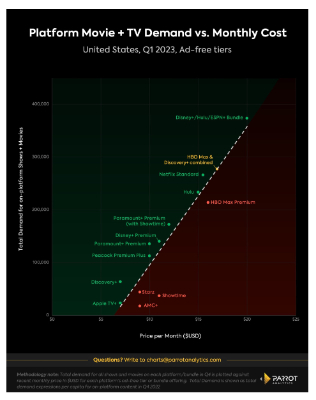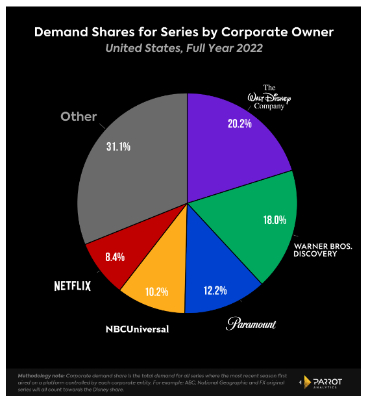Roughly one year after merging, Warner Bros. Discovery is finally ready to unveil the conglomerate’s raison d'etre: a streaming service bringing Discovery+ and HBO Max’s content together in a general entertainment platform to rival Netflix and the Disney bundle.
Parrot Analytics data reveals that the combined service will provide a strong value for consumers in terms of dollars spent vs total content demand provided, and that Discovery+ series will fill in the older female demographic hole that HBO Max is not currently serving.
On the surface this looks like a true four quadrant service at a fair price that can be incrementally increased over the years to increase APRU. That said, it remains to be seen whether any affinity or overlap exists between the respective audiences of Discovery+ and HBO Max.
HBO Max needed to increase time spent on the platform, and Discovery+’s content is designed to do just that — it’s the rewatchable shows consumers put on in the background while cooking or folding laundry. This strategy should help improve subscriber retention, which will lead to higher ARPU. However, it does little to immediately address subscriber acquisition, which has plateaued for Warner Bros. Discovery in recent quarters.
See below for more data on what each platform brings to the table, and whether Warner Bros. Discovery has the goods to be one of the Big Three players in streaming entertainment.
Ad-Free Price x Content Demand

- A fair price for a combo of HBO Max and Discovery+ would be roughly $17 per month, based on total demand available on each platform, if all Discovery+ content is put on the combined service.
- As stand-alones, we find HBO Max is slightly overpriced by about $1.50/m compared to the total demand for content available on the platform, while Discovery+ is underpriced by ~$2.00/m.
- The reported ad free starting price of $16/m thus provides a much better overall deal for consumers than the current HBO Max Premium offering. It also gives Warner Bros. Discovery room for incremental price increases that should not receive too much blowback from consumers.
2022 US Corporate Demand Share

- Corporate demand share assesses the long-term viability of the top media companies as they look to consolidate their original content’s availability exclusively onto their own platforms.
- However, with Wall Street’s mandate to focus back on profits, this view of the entertainment landscape can also be used to assess which companies have the most valuable content to license out, rebooting one of the original revenue streams in the TV business. It can effectively help value a conglomerate’s legacy and library content in aggregate.
- Disney (20.2%) and Warner Bros. Discovery (18.0%) are in a class of their own when it comes to corporate demand share. While Netflix is still the leader in many streaming-only metrics, Disney and Warner Bros. Discovery have the overall catalog content to both build out general entertainment streaming services, and to significantly boost licensing revenue by selling to competitors.
- With FASTs becoming an increasingly important part of the streaming ecosystem, Warner Bros. Discovery is poised to benefit from the demand for its catalog. It has already announced FAST channel deals with Roku and Tubi and is planning an in-house FAST channel.
- WBD is roughly one year away from being able to sell itself off: any combination of WBD and NBCU or Paramount would leapfrog Disney as the dominant player in corporate demand share.
Demographic Data: HBO Max & Discovery+

- Audience demographic data shows very little overlap between the respective audiences for HBO Max exclusive titles and Discovery+ exclusive titles.
- HBO Max is effectively a ‘three quadrant’ service as is. Its TV series are resonating with older and younger males as well as younger females.
- Discovery+ is largely a ‘one quadrant’ service, with a heavy skew to older female audiences. This makes sense given the content available on HGTV, Food Network, Animal Planet, etc.
- This data shows why the strategy of moving forward with a combined service, while also keep Discovery+ as a standalone is smart. The Discovery+ audience would likely not support being forced onto a larger — and more expensive — platform. But the combination will add a major amount of content for older female audiences who weren’t being served on HBO Max.



 Fix & Fogg: NASA Hand-picks Kiwi Nut Butter Brand To Travel To Space In NZ First
Fix & Fogg: NASA Hand-picks Kiwi Nut Butter Brand To Travel To Space In NZ First Citizens of the Sea: Sailors To Revolutionise Our Understanding Of Pacific Biodiversity
Citizens of the Sea: Sailors To Revolutionise Our Understanding Of Pacific Biodiversity Netsafe: Making A Splash With Online Safety: Netsafe Launches New Flagship Programme For Kids
Netsafe: Making A Splash With Online Safety: Netsafe Launches New Flagship Programme For Kids NZGBC: Flood Resilience PhD Student Widi Auliagisni Named Future Thinker Of The Year 2024
NZGBC: Flood Resilience PhD Student Widi Auliagisni Named Future Thinker Of The Year 2024 Business Canterbury: European Free Trade Agreement A Game-changer For Canterbury
Business Canterbury: European Free Trade Agreement A Game-changer For Canterbury Business Canterbury: Urges Council To Cut Costs, Not Ambition For City
Business Canterbury: Urges Council To Cut Costs, Not Ambition For City



